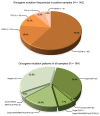Comprehensive profiling and quantitation of oncogenic mutations in non small-cell lung carcinoma using single molecule amplification and re-sequencing technology
- PMID: 27409166
- PMCID: PMC5226597
- DOI: 10.18632/oncotarget.10464
Comprehensive profiling and quantitation of oncogenic mutations in non small-cell lung carcinoma using single molecule amplification and re-sequencing technology
Abstract
Activating and resistance mutations in the tyrosine kinase domain of several oncogenes are frequently associated with non-small cell lung carcinoma (NSCLC). In this study we assessed the frequency, type and abundance of EGFR, KRAS, BRAF, TP53 and ALK mutations in tumour specimens from 184 patients with early and late stage disease using single molecule amplification and re-sequencing technology (SMART). Based on modelling of EGFR mutations, the detection sensitivity of the SMART assay was at least 0.1%. Benchmarking EGFR mutation detection against the gold standard ARMS-PCR assay, SMART assay had a sensitivity and specificity of 98.7% and 99.0%. Amongst the 184 samples, EGFR mutations were the most prevalent (59.9%), followed by KRAS (16.9%), TP53 (12.7%), EML4-ALK fusions (6.3%) and BRAF (4.2%) mutations. The abundance and types of mutations in tumour specimens were extremely heterogeneous, involving either monoclonal (51.6%) or polyclonal (12.6%) mutation events. At the clinical level, although the spectrum of tumour mutation(s) was unique to each patient, the overall patterns in early or advanced stage disease were relatively similar. Based on these findings, we propose that personalized profiling and quantitation of clinically significant oncogenic mutations will allow better classification of patients according to tumour characteristics and provide clinicians with important ancillary information for treatment decision-making.
Keywords: allele-specific amplification refractory mutation system; non small-cell lung carcinoma; oncogenic mutations; single molecule amplification and re-sequencing technology.
Conflict of interest statement
YS, JZ, MX and DSC are employees of Berry Genomic Corporation, Beijing
Figures






Similar articles
-
Comprehensive profiling and quantitation of oncogenic mutations in non-small cell lung carcinoma using single-molecule amplification and re-sequencing technology.Tumour Biol. 2017 Feb;39(2):1010428317691413. doi: 10.1177/1010428317691413. Tumour Biol. 2017. PMID: 28218040
-
Molecular alterations in non-small cell lung carcinomas of the young.Hum Pathol. 2014 Dec;45(12):2379-87. doi: 10.1016/j.humpath.2014.08.005. Epub 2014 Sep 2. Hum Pathol. 2014. PMID: 25288236
-
Using whole genome amplification (WGA) of low-volume biopsies to assess the prognostic role of EGFR, KRAS, p53, and CMET mutations in advanced-stage non-small cell lung cancer (NSCLC).J Thorac Oncol. 2009 Jan;4(1):12-21. doi: 10.1097/JTO.0b013e3181913e28. J Thorac Oncol. 2009. PMID: 19096301
-
Somatic mutations and immune checkpoint biomarkers.Respirology. 2019 Mar;24(3):215-226. doi: 10.1111/resp.13463. Epub 2019 Jan 12. Respirology. 2019. PMID: 30636374 Review.
-
Co-occurring genomic alterations in non-small-cell lung cancer biology and therapy.Nat Rev Cancer. 2019 Sep;19(9):495-509. doi: 10.1038/s41568-019-0179-8. Epub 2019 Aug 12. Nat Rev Cancer. 2019. PMID: 31406302 Free PMC article. Review.
Cited by
-
Comparison of the Amplification Refractory Mutation System, Super Amplification Refractory Mutation System, and Droplet Digital PCR for T790 M Mutation Detection in Non-small Cell Lung Cancer after Failure of Tyrosine Kinase Inhibitor Treatment.Pathol Oncol Res. 2018 Oct;24(4):843-851. doi: 10.1007/s12253-017-0286-3. Epub 2017 Sep 3. Pathol Oncol Res. 2018. PMID: 28868565
-
Genetic profiling of primary and secondary tumors from patients with lung adenocarcinoma and bone metastases reveals targeted therapy options.Mol Med. 2020 Sep 17;26(1):88. doi: 10.1186/s10020-020-00197-9. Mol Med. 2020. PMID: 32942985 Free PMC article.
-
Cell-Free Circulating Tumour DNA Blood Testing to Detect EGFR T790M Mutation in People With Advanced Non-Small Cell Lung Cancer: A Health Technology Assessment.Ont Health Technol Assess Ser. 2020 Mar 6;20(5):1-176. eCollection 2020. Ont Health Technol Assess Ser. 2020. PMID: 32206157 Free PMC article.
-
Plasma EGFR mutation abundance affects clinical response to first-line EGFR-TKIs in patients with advanced non-small cell lung cancer.Ann Transl Med. 2021 Apr;9(8):635. doi: 10.21037/atm-20-7155. Ann Transl Med. 2021. PMID: 33987333 Free PMC article.
-
Gene-Guided Treatment Decision-Making in Non-Small Cell Lung Cancer - A Systematic Review.Front Oncol. 2021 Oct 12;11:754427. doi: 10.3389/fonc.2021.754427. eCollection 2021. Front Oncol. 2021. PMID: 34712614 Free PMC article.
References
-
- Zhou JX, Yang H, Deng Q, Gu X, He P, Lin Y, Zhao M, Jiang J, Chen H, Lin Y, Yin W, Mo L, He J. Oncogenic driver mutations in patients with non-small-cell lung cancer at various clinical stages. Ann Oncol. 2013;24:1319–1325. - PubMed
-
- Black RC, Khurshid H. NSCLC: An Update of Driver Mutations, Their Role in Pathogenesis and Clinical Significance. R I Med J (2013) 2015;98:25–28. - PubMed
-
- Devarakonda S, Morgensztern D, Govindan R. Genomic alterations in lung adenocarcinoma. Lancet Oncol. 2015;16:e342–e351. - PubMed
-
- Califano R, Abidin A, Tariq NU, Economopoulou P, Metro G, Mountzios G. Beyond EGFR and ALK inhibition: unravelling and exploiting novel genetic alterations in advanced non small-cell lung cancer. Cancer Treat Rev. 2015;41:401–411. - PubMed
-
- Rikova K, Guo A, Zeng Q, Possemato A, Yu J, Haack H, Nardone J, Lee K, Reeves C, Li Y, Hu Y, Tan Z, Stokes M, et al. Global survey of phosphotyrosine signaling identifies oncogenic kinases in lung cancer. Cell. 2007;131:1190–1203. - PubMed
MeSH terms
Substances
LinkOut - more resources
Full Text Sources
Other Literature Sources
Medical
Research Materials
Miscellaneous

